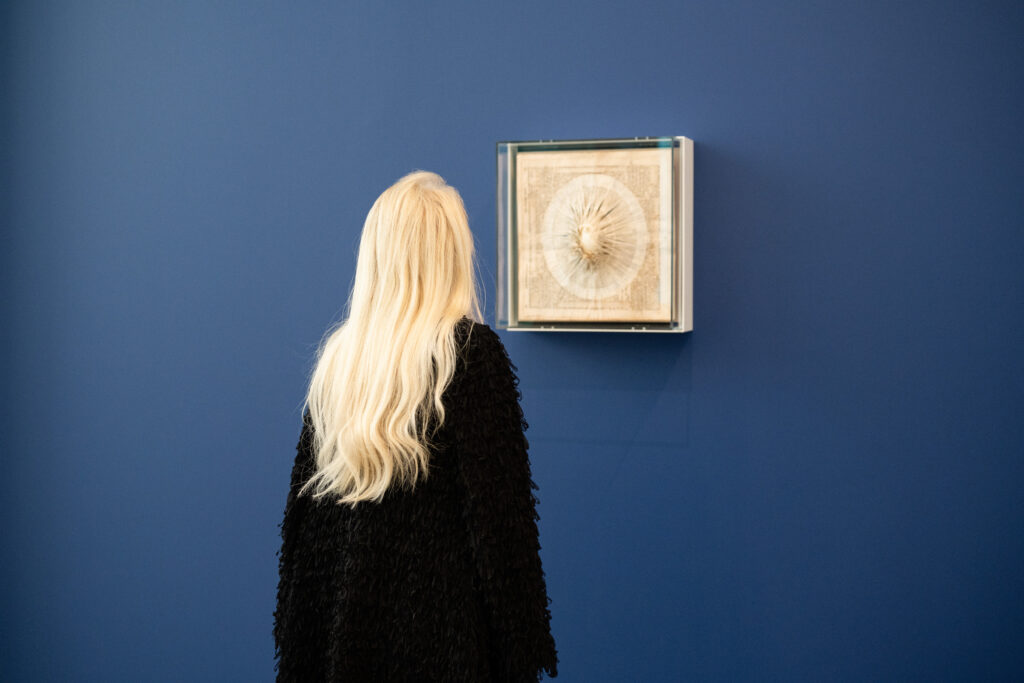Inspired Encounters: Women Artists and the Legacies of Modern Art began in 2019 with an exercise of imagination. Standing in the modern art galleries of Kykuit, the former home of four generations of the Rockefeller family that opened as a public historic house museum in 1994, our conversation turned on a question: If the work of exclusively women artists remained in Nelson A. Rockefeller’s legendary collection of twentieth-century art, what modernisms would unfold? Thereafter, we were given the opportunity to visualize our answer in exhibition form for a new gallery space at the David Rockefeller Creative Arts Center. An exciting prospect, it would be the first time this grouping of artworks would leave their domestic setting at Kykuit, enabling us to subtly expand the possibilities of this “closed” collection so that the past seems more inclusive, and the collection’s resonance more expansive.

Surveying the full presentation, which comprises work across media made between the years 1950 and 1970, the eye catches names familiar to many: Lee Bontecou, Marisol, and Louise Nevelson. There are artists, too, whose contributions remain ripe for reassessment: Mary Bauermeister, Dorothy Dehner, Grace Hartigan, and Louise Kruger. There are others, namely Anni Albers and Lenore Tawney, who have greatly benefited from similar reconsiderations in recent years. And then there are artists whose legacies remain hidden in plain sight: Mary Callery, whose work adorns the proscenium arch of the Metropolitan Opera House in New York City, and Valerie Clarebout, whose dozen angels have annually graced Rockefeller Center for the past six decades.
Whether consciously or not, so many contemporary women artists engage with the legacies of these modern artists, whose creative accomplishments paved the way for subsequent generations. This led us to the idea of staging a dialogue across time by inviting artists Sonya Clark, Maren Hassinger, Elana Herzog, Melissa Meyer, Fanny Sanín, Barbara Takenaga, and Kay WalkingStick to respond to the museum and grounds at Pocantico with artwork for the exhibition. The result is a series of inspired encounters that frames the modern art of the postwar period as relevant, generative, and open to myriad creative possibilities.
Soon after formalizing the exhibition conceptually, we turned our attention toward the logistics of exhibiting the nearly fifty works of art on the checklist. Consulting with several conservators in different specialties, it became clear that the conservation and display needs for the works from Kykuit’s collection were substantial, and that many works required rehousing and reframing to ensure that they are shown to their best advantage and preserved for the future. A complex Plexiglas sculpture by Louise Nevelson, Transparent Sculpture VII (1967-68), was encased in an acrylic box that made it difficult to see between the glare and layering of transparent elements inside. The vibrant colors and varied textures of an untitled embroidery sampler by Valerie Clarebout, as well as the details of an intricate collage by Lenore Tawney, were obscured by aged acrylic cases. In addition, about a dozen works needed to be newly framed. Over the next year, a team of devoted specialists helped to prepare these works for exhibition.
A generous Foundation for Advancement in Conservation (FAIC)/Tru Vue® Conservation and Exhibition Grant made it possible for the objects to be reglazed with Tru Vue® Optium Museum Acrylic®, which completely transformed their viewing experience and provided them with much-needed protection. The collage by Lenore Tawney was treated by conservator Gwen Spicer who rehoused it in a Sealed Wall Case by SmallCorp fitted with Optium Museum Acrylic, which provides both UV protection and a microclimate for the fragile paper strips of paper held within. When the artist originally exhibited this work in 1967, it was unframed, allowing an intimate encounter with the piece–it is wonderful that the new case provides more visibility and interaction with the piece than its previous housing. A new display box for the Nevelson sculpture was fabricated in Optium Museum Acrylic, also by SmallCorp, Inc. The clarity and legibility of the work is now greatly enhanced due to the anti-reflective properties of the Optium.


With its qualities of an abstract painting, it was important that the Clarebout embroidery be displayed like one, in a wooden frame that would elevate it and diminish the line between craft and fine art, which is one of the major aims of the show. First it was cleaned and remounted on honeycomb aluminum by Gwen Spicer. Then we worked with expert framer Ursula Hobson in Philadelphia to select an appropriate maple frame with a linen interior and Optium Museum Acrylic glazing. Because this is a relatively large piece, it is advantageous that the Optium is lightweight and shatterproof, plus the anti-static properties provide additional protection. One of our hopes is that showcasing these works of art will remind viewers that Clarebout and other women artists within and without the exhibition deserve to be included in the historical record and to have their work preserved for future generations of viewers.

The exhibit is on view at the David Rockefeller Creative Arts Center until July 29, 2023.
Share this Article:
This article is intended for educational purposes only and does not replace independent professional judgment. Statements of fact and opinions expressed are those of the author(s) individually and, unless expressly stated to the contrary, are not the opinion or position of Tru Vue or its employees. Tru Vue does not endorse or approve, and assumes no responsibility for, the content, accuracy or completeness of the information presented.
